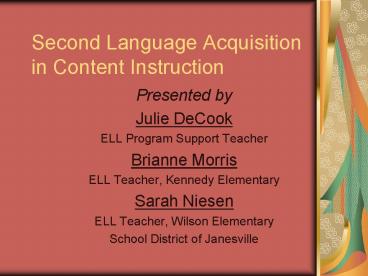Second Language Acquisition in Content Instruction - PowerPoint PPT Presentation
1 / 19
Title:
Second Language Acquisition in Content Instruction
Description:
Personality Traits can help or hinder. Universal Grammar/ Language ... During free playtime. In informal discussion. INFORMAL SETTINGS. BICS can be heard... – PowerPoint PPT presentation
Number of Views:746
Avg rating:3.0/5.0
Title: Second Language Acquisition in Content Instruction
1
Second Language Acquisition in Content
Instruction
- Presented by
- Julie DeCook
- ELL Program Support Teacher
- Brianne Morris
- ELL Teacher, Kennedy Elementary
- Sarah Niesen
- ELL Teacher, Wilson Elementary
- School District of Janesville
2
- Adapted from
- Second Language Acquisition
- A Staff Development Presentation
- By
- Julie DeCook
- Heather Casey
- Matt Wolf
- Shelly Kier
- ELL Program, The School District of Janesville
3
Second Language What?
- Acquisition most language is acquired not
learned. - Think of first language development.
- How do our brains acquire language?
4
Ideas from SLA Theory
- Personality Traits can help or hinder
- Universal Grammar/ Language Acquisition Device
(Chomsky) - Comprehensible Input (I 1) (Krashen)
- Affective Filter and the Monitor (Krashen)
- Zone of Proximal Development (ZPD) (Vygotsky)
5
Sociocultural Theories
- The more alike the first and target cultures are,
the more likely SLA will go well. (Schumann) - The circumstances under which the learner arrived
(voluntary immigrant, refugee,etc.) can help or
hinder. (Ogbu) - Learners will invest themselves when they believe
their efforts will bring them a return. - (Norton Peirce)
6
What Does SLA Look Like?
- Errors/Overgeneralizations
- gaved, mices, she going, . . .
- Silent Period
- Comprehension better than expression
- Transfer The car red.
7
Notions of Language
- Fixed/limited entity that can be fully acquired
- oral proficiency
- BICS (Basic Interpersonal Communication Skills)
vs. CALP (Cognitive Academic Language
Proficiency) - Discoursessocially situated practicesmultiple
and dynamic (Gee)
8
Notions of Literacy
- Fixed ability to read/write either can or cant
- Levels of literacy
- Literacy in various genres
- Types of literacycomputer literacy, music
literacy, etc. - Discoursesways of being including talking,
reading, writing, acting, havingidentities.
9
Notions of Proficiency
- A single abilityeither proficient or not
- Levels of proficiency
- Proficiency per language skill listening,
speaking, reading, writing - Types of proficiency math, driving, etc.
- Relative to expectations
- Recognition and participation as a true member
of specific communities
10
Notions of Learners
- Fixed core
- Introvert / Extrovert
- Motivated / Unmotivated
- Risk-taker / Observer
- Multiple (may have different traits in different
environments), dynamic, contradictory
11
J.Cummins Language Acquisition
- BICSBasic Interpersonal Communication Skills
- CALPCognitive Academic Language Proficiency
12
B I C S
- CONTEXTUAL CUES
- QUICKLY EASILY OBTAINED
- APPEALING TO BICS
- Videos
- Hands-on learning
- Visual examples
13
BICS can be heard
- In reflections
- In peer conversation
- During free playtime
- In informal discussion
- INFORMAL SETTINGS
14
CALP can be heard/seen
- In written essays
- In analysis / reviews
- In classroom discussion
- In explanation of high-level concepts
- MORE FORMAL SETTINGS
15
So how long does it take?
- Reaching the 50th percentile on standardized
reading tests - With primary language literacy
- 4 to 7 years
- With no primary language literacy
- 7 to 10 years
16
So what does effective content instruction look
like?
- Context-rich environment and activities with
opportunities for speaking, listening, reading,
and writing - Comprehensible Input (I 1)
- Emotionally safe zone that supports risk-taking
- Interaction with native-English-speaking peers
17
- Representation of and attention to
- cultural and linguistic role models
- successful in the field
- No penalization for linguistic errors
- Multi-modal expression of knowledge
- Direct, explicit instruction on how to
- talk, think, read, and write like a scientist,
- etc.
- First cultures and cultural identities are
respected and valued students are - supported through culture and identity
- conflict
18
- Focus on CALP Direct instruction and modeling of
academic language. - Example prompt
- Contrast virus and bacteria.
- Example answer
- Virus . . .
- Bacteria . . .
- Assess skills and knowledge through meaningful
assessment not through - BICS or years in an English
- environment.
19
Delivery Models in Janesville
- Co-teaching
- Pull-out
- Collaboration Model ELL Content Support Classes
(Pre-, re-, parallel- teaching of vocab and
concepts homework help).































